Notes on Herb Gardens
Despite not being able to keep the dog out of the herb garden, the plants are all performing beautifully. They continue to bounce back from his constant trampling, determined to stand up to his mischievous little paws. I persistently reprimand him for his actions, but he conveniently fails to understand my words and goes about his business as usual.
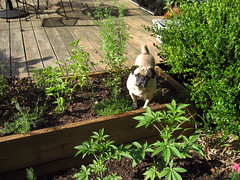
Herbs are actually very easy to grow, and most thrive when neglected rather than pampered. Most herbs are annual plants originating from the Mediterranean, where the soil is sandy and dry and not all that rich in nutrients. Most hybrid varieties that we grow today still prefer the conditions of their foreplants - keep them on the dry side, and don't fertilize. The one exception I have found is chamomile, which prefers a damp soil and will wilt dramatically when the soil shows the first signs of drought.
An annual plant is one that lives for at most one year, with the sole purpose of reproducing. Annuals are like the flies of the plant world - purposed to reproduce and then die. Once an annual produces seed, it dies back and lets its offspring carry on the family line.
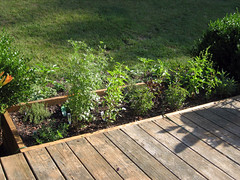
Some annuals are intent on producing seed very quickly and must be tended to promptly to help prolong their lives. When annual basil begins to flower, it is wise to pinch the flowers back not only to keep the plant from dying, but also to encourage new growth.
This red rubin basil is determined to go to seed, but I have been quick to interfere with its plans on a daily basis.
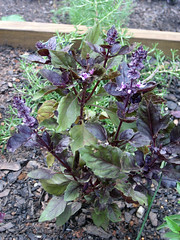
Pinching the flowers back is very easy and can be done with no special tools - you just need a finger and a thumb. Grasp the base of the flowering stem between your finger and thumb and pinch with your thumbnail to prune off the flowering growth.
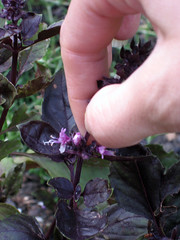
This method will actually encourage the plant to produce even more flavorful sprigs.
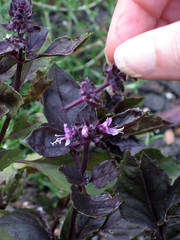
The plant has not actually "gone to seed" until the flowers begin to produce seed, so you do not have to be too quick to pinch off the flowers. If you enjoy the look of the flowers, you can wait until they begin to fade before pinching them off, as you do with decorative annuals. Shearing off spent flowers from decorative annuals will keep them in bloom longer and promote new bushier growth and more prolific flowering.
Cilantro is one herb that is especially intent on going to seed at an early age. When you are finished harvesting your cilantro or just tired of fighting its desire to flower, let it go to seed. You can then harvest the seeds for use in the kitchen, as this is where coriander originates.
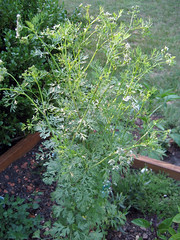
Our marjoram has also been insistent that we allow it to flower, but I continue to pinch it back with each attempt.
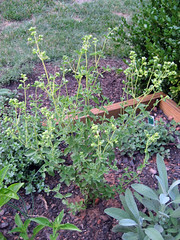
We designed a cute little flower garden in front of the herb garden in our attempts to keep the dog out of it, but it has not worked so far. The flower bed contains annual and perennial ornamentals such as cleome, canterbury bells and salvia, and additional herbs such as fennel, lemongrass and lavender.
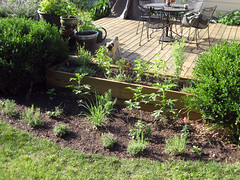
I am hoping that once the cleome is taller, he will get the point. Maybe I should have planted some roses here so he really would get "the point" when he launched into the air. Cleome (otherwise known as spider flower for its spider-like blooms) is an annual in our region and grows to 4 feet in height. I grew these plants from seed sown in mid-February. The seeds took a really long time to germinate, and I had actually written them off as a failure after 4 weeks with no sprouts. They surprised me one day when they finally sent up shoots from their long forgotten peat pods. Although they were slow to germinate, the success rate was near 100%.
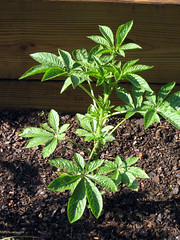
I sowed these perennial canterbury bells around the same time as the cleome, but they have been much slower growing and have had a lower success rate than expected.
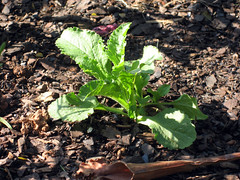
I found these lavender plants on the clearance rack at Lowe's for just $1 each! I don't recommend purchasing "bargain" plants for an area that you really care about, but these plants looked strong and unstressed. Usually the bargain plants at Lowe's are beyond recovery, but these plants were in perfect condition. When I went back the following week though, they had all but killed the remaining lavender on the bargain rack. I guess that's where they send plants to die.
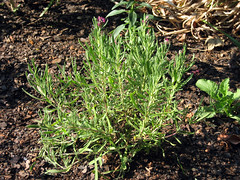
We have enjoyed the herb garden very much. We enjoy their decorative qualities, we love to lounge around on the deck taking in their spicy odor, and of course, we appreciate the flavor they add to our dinners!

0 Comments:
Post a Comment
Subscribe to Post Comments [Atom]
<< Home